on Lexus, EV issues & LEGO at Le Mans
Lexus brings new SUVs. . .mobile charger. . .the Volvo EX30 and carbon. . .SEMA and the EPA. . .material dependencies. . .adventures at Le Mans. . .
Lexus Grows the SUV Portfolio

The all-new 2024 Lexus TX. Built in Indiana. Aimed at those who are interested in three rows of seating. (Image: Lexus)
- Mindset
- Skill set
- Process capability
“Mindset is the most important,” says Leah Curry, president of Toyota Motor Manufacturing, Indiana (TMMI). The TMMI plant in Princeton, Indiana, is where the all-new Lexus TX is going into production.
The three-row TX is joining the Sienna, Highlander and Grand Highlander in the plant.
Those vehicles, of course, carry the Toyota badge.
So the question becomes how do the associates at TMMI execute a Lexus?
Which goes to the point of mindset. Curry says that they have become steeped in the expectation that Lexus customers—or “guests,” in Lexus parlance—have for their vehicles.
What’s more, there was input provided by other North American Toyota team members that are familiar with building Lexus models—associates from the plant in Cambridge, Ontario, where the RX is built; associates from the plant in Georgetown, Kentucky, where the ES is built—as well as from Japan-based operations.
Skills and process capabilities go without saying.
Mindset takes things to a higher level.
~~~
Dejuan Ross is group vice president and general manager, Lexus Division.
No surprise that he thinks the three-row crossover will be highly successful in the market.
There are other Lexus SUVs with three rows. The LX and the GX (more on this below).
And up until the new generation of the crossover (MY 2023), there was the RX-L.
The LX is a top-of-the-line model (i.e., starting at $92,160). The GX is for those who want lux and off-road capability.
The RX-L, which is arguably closer to what the TX is in terms of being a unibody vehicle, was something of a kludge. (It was a s-t-r-e-t-c-h-e-d two-row RX.)
Ross, being diplomatic, notes consumers guests will find the interior cargo volume highly appealing compared to the RX-L: with all rows folded there are 97 cubic feet for cargo in the TX compared with 58.48 cubic feet for the RX-L.
He thinks the TX will be a big hit for those with larger families.
Like his own. He and his wife have four kids.
~~~
Stylistically, the TX brings a long, lean, sharp look. One of the most notable changes to what has now been a (controversial) feature of the front end of a Lexus is that the “spindle grille”(which has always seemed to be an “hourglass grille”) is now designated “Unified Spindle.” It is more of a trapezoid with horizontal slats: restrained and serious looking. Along the top of the grille there is a light link connecting the headlights. Sleek, not showy.
The thin horizontal lamp motif extends around to the back of the vehicle, as well.
On the body side there is an interesting spear-shape at the top of the blacked-out D-pillar.
Overall, an execution that looks lux: quietly confident.
~~~
The TX comes in four grades: Standard, Premium, Luxury, and F SPORT Performance.
But is what is more interesting is that it is available with three powertrain options:
- TX 350: A 275-hp turbocharged 2.4-liter four mated to an eight-speed automatic.
- TX 500h: A parallel hybrid system that uses a 2.4 liter turbo four for the combustion part and motors that amp up the total output to 366 hp.
- TX 550h+: A plug-in hybrid that uses a 3.5-liter V6; total system horsepower: 406. The on-board battery provides a full-electric range of an estimated 33 miles.
Two out of three hybrids.
The first two versions will be available in the fall. The 550+ at a later date.
~~~
And There’s This
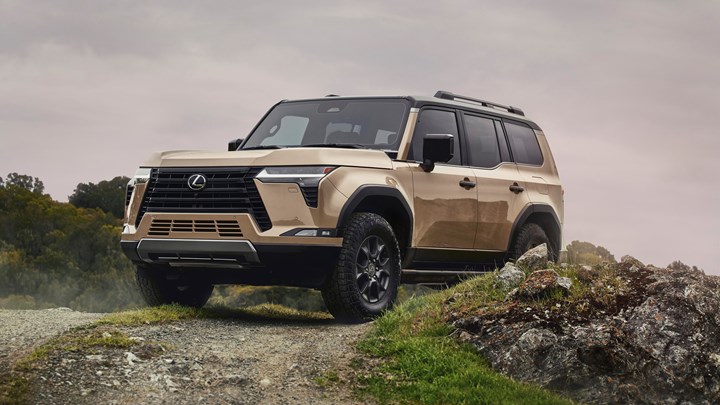
The 2024 Lexus GX. It is as capable as it looks. (Image: Lexus)
While the TX is an all-new entry into the suite of SUV offerings (UX, NX, RX, LX), the GX has been available since model year 2003.
The GX was something of a Toyota 4Runner for the set that would buy their clothing from Orvis rather than the Gap.
There was a second generation in model year 2010, and while there were certainly improvements, this was more of an evolution of its predecessor than something that was discernibly different.
And for the third generation, the 2024 GX, this is Discernibly Different, not only from what has gone before, but from other body-on-frame utes in the market.
That is, the styling of the ’24 GX is dominated by (seemingly) flat surfaces and crisp edges. It is a no-nonsense look. Should someone take it off road—and know that the GX uses the same GA-F ladder-frame platform that is also used on products like the Toyota Tundra pickup so it can take it—there would be no need to have any explaining to do: the presence of the design telegraphs capability.*
And this isn’t just apparent capability. There is standard full-time four-wheel drive with a Torsen limited-slip center differential with a locking feature. Among the six grades for the vehicle are Overtrail and Overtrail+. They are also equipped with an electronic locking rear differential.
Because odds are really good that people are going to spend more time on tarmac than at trail heads, the GX has a new double-wishbone front suspension and a multi-link rear that facilitate the former as well as the latter.
In terms of propulsion, there is a twin-turbocharged 349-hp 3.4-liter V6 mated to a 10-speed transmission. As this is something meant to crawl as well as cruise, it is notable that it produces 479 lb-ft of torque.
At some point the GX is going to be fitted with a hybrid powertrain.
Were you to be blindfolded then put behind the steering wheel of the ’24 GX, with the leather and the 12.3-inch infotainment display and other amenities, you might think that you were in something that would be the last thing you’d consider taking off road (a.k.a., car). Of course, you might see the “DAC Crawl” mode, which sort of gives it away.
*What’s interesting to think about is that the design of the GX is in some ways reminiscent of Range Rovers of days of yore, but whereas the form of a Range Rover today is soft, the GX has gone serious.
///
Mobile Charge at the Airport
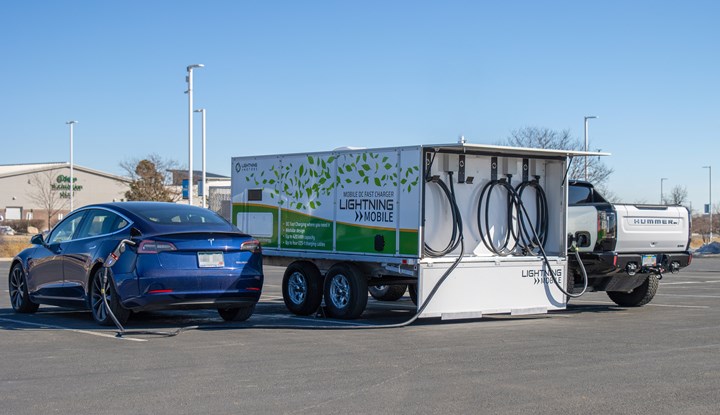
The mobile EV charger can be used in places where electricity is needed but the infrastructure has yet to be built. (Image: Lightning eMotors)
While everyone knows there needs to be more electric vehicle chargers, not everyone knows the number of chargers that are needed at any given locale. Too few can be annoying. Too many can be expensive.
So to get a handle on demand, there will be an experiment of sorts next week at Dallas Fort Worth International Airport (DFW) with the Lightning Mobile DC Fast Charger from Lightning eMotors. This unit-on-wheels offers from 105- 420-kWh battery capacity and both Level 2 AC charging and DC fast charging.
Each unit can charge up to five vehicles.
The airport personnel will be able to determine how many vehicles are charging and how much charge they are taking.
(One can imagine that something like the mobile charger would be useful at airports to address the issue of someone coming back from a long trip, having left their EV at a low state of charge, in the kind of heat that Dallas experiences in July and August, and finding the battery in need of a boost.)
///Can Smaller EVs Become Compelling?
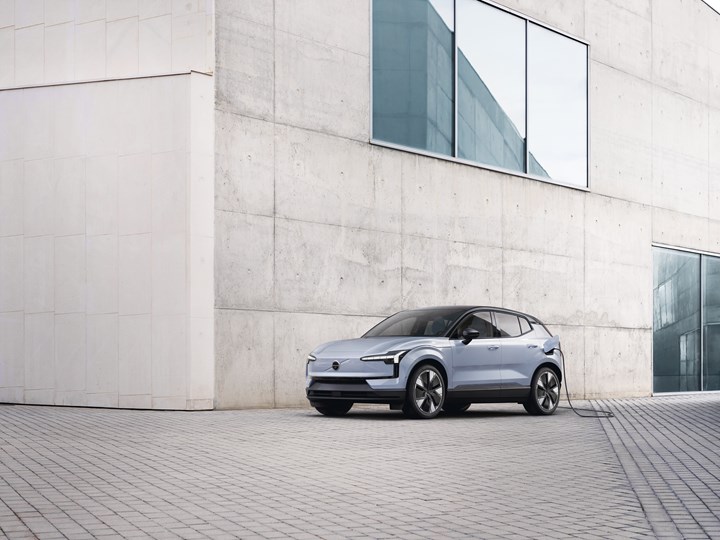
Volvo EX30: Reducing carbon isn’t only about propulsion. (Image: Volvo)
Will the Volvo EX30, a small EV crossover, have an effect on the EVs being offered in the market given its compelling environmental case?
Like a 25% total lifecycle carbon reduction compared to the company’s C40 and XC40, both of which are EVs?
Anders Kärrberg, Vovlo global head of sustainability: “By 2025, we aim to reduce our overall CO2 emissions per car by 40 percent from 2018 levels through a 50 percent reduction in overall tailpipe emissions, and a 25 percent reduction in emissions from our operations, raw material sourcing and supply chain – all on the way towards our ambition of being a climate neutral company by 2040.”
The EX30 is a move in the right direction.
One important reason why the EX30 is more environmentally benign: It is smaller than the other vehicles Volvo presently has on offer.
Volvo points out:
- A smaller vehicle means less material is required to produce it
- Aluminum and steel are two of the biggest production-related contributors to CO2 emissions
- Therefore: less material = fewer emissions
What’s more, approximately 25% of the aluminum and some 17% of the steel used in the vehicle are recycled, so that helps bring down the carbon.
On the production front, the EX30 factory uses 100% climate-neutral electricity.
Volvo has also worked with its Tier 1 suppliers such that 95% of them have committed to be using 100% renewable energy by 2025, and reportedly several are already at that level.
And beyond the aluminum and steel, there are interior materials including recycled denim and flax that contribute to its environmental cred.
Size Matters
But the important part is arguably the size: 166.7 inches long, 61.1 inches high, 72.3 inches wide and with a 104.3-inch wheelbase. It offers 14 cubic-feet of storage behind the second row and 32 with the seat folded.
The EX30 will start in the U.S. (this is a global product: the plant in question is based in China) at $36,145 (coming with a 64-kWh battery and a single 268 hp motor and providing a projected range of 275 miles (not yet EPA certified)).
Maybe right-sized vehicles will become more compelling to more buyers.
And that will provide an environmental boost to zero-emissions vehicles.
(On the subject of right-sizing: How many people actually need, from a functional perspective, a full-sized pickup truck, electric or otherwise? While there may be zero emissions from an EV pickup, there are still all of the resources involved in its construction, so for those who truly want to be environmentally responsible, that is not the right vehicular choice. And one of the benefits of an electric propulsion system is that it facilitates more interior room. So even smaller EV SUVs can be comparable in terms of interior space as larger vehicles, so it wouldn’t be necessary to default to something bigger thanks to that propulusion architecture change.)
///
SEMA Smacks Proposed EPA Standards

The Dodge Charger Daytona SRT concept. The kind of car that plenty of SEMA members like. And it happens to be electric. (Image: Dodge)
The proposed EPA standard—“Multi-Pollutant Emissions Standards for Model Years 2027 and Later Light-Duty and Medium-Duty Vehicles”—that would require automakers to achieve a fleet average of emissions of 82 grams/mile and consequently (so the calculations have it) mean that 67% of new light vehicles would be zero emissions by 2032 is open for comment until July 5.
Which essentially means that interested parties can put their proverbial two cents in about the proposal.
In the case of the Specialty Equipment Market Association (SEMA) it is more like $17-billion.
Testifying
SEMA president and CEO Mike Spagnola testified before the EPA on the subject.
After pointing out that the organization represents over 7,000 companies that manufacture and sell parts—95% of those companies, he said, being considered “small businesses”—he, perhaps not surprisingly, spoke out against the EPA’s proposal, as in:
"SEMA and its members have serious concerns with this proposal, which aggressively seeks to lower carbon emissions under timelines that effectively make electric vehicles the de facto choice option for automakers to meet the requirements.”
But then there was a point against industrial policy:
“Government shouldn't pick winners and losers”. . .
. . .and even a thwack against the big businesses that are the automotive OEMs:
“This far too-fast mandate will create a seismic shift for small businesses who don't have the capacity to make the shift this quickly, especially when they're not receiving billions in government funds like the large automakers are to fund their electric vehicle programs. To put this in perspective, 33% of consumer spending on performance and accessory products goes toward upgrading ICE engines and drivetrains. That's nearly $17 billion of the $51 billion specialty aftermarket industry. That's $17 billion of impact largely on small businesses.”
Ouch!
Shape of Things to Come
Arguably one of the most-significant vehicles on display at last fall’s SEMA Show in Las Vegas was the Dodge Charger Daytona SRT Concept.
Talking about the display, Tim Kuniskis, Dodge brand CEO, said last November:
“The SEMA Show is one of the great gatherings of the performance culture, and Dodge isn’t going to shy away as we develop the next generation of muscle car – one that just happens to be fully electric.
“Technology moves forward and the customizers and tuners move right along with it. We’re demonstrating how old-school hot-rodding will thrive in an electrified muscle-car future.”
Apparently the speed of that movement is what has SEMA concerned.
Although Dodge hasn’t revealed the speed of the Charger Daytona SRT (it is, after all, a concept vehicle), it is worth noting that it did reveal power numbers, with the base model at 455 hp going up to a version that produces 670 hp.
Either way: fast.
///
Materials Matter
- Dysprosium
- Neodymium
- Manganese
- Niobium
Probably not materials you think about much. If at all.
But the European Commission sponsored a study into these materials conducted by Chalmers University of Technology, figuring that because of both vehicular electrification and digitization these metals are of potential concern.
And arguably the potential concern is legitimate concern. And probably it is the same in the U.S. as in the EU.
Here’s Maria Ljunggren, Associate Professor in Sustainable Materials Management at Chalmers University of Technology:
“The EU is heavily dependent on imports of these metals because extraction is concentrated in a few countries such as China, South Africa and Brazil. The lack of availability is both an economic and an environmental problem for the EU, and risks delaying the transition to electric cars and environmentally sustainable technologies.”
Working with the Swiss Federal Laboratories for Materials Science and Technology, Ljunggren and her colleagues made a database that looks at the materials from 2006 until now.
Ljunggren:
“Neodymium and dysprosium usage has increased by around 400 and 1,700 percent respectively in new cars over the period, and this is even before electrification had taken off.”
Presumably, now that it has taken off that demand is even greater.
While recycling is a possibility, she points out:
“If recycling is to increase, cars need to be designed to enable these metals to be recovered, while incentives and flexible processes for more recycling need to be put in place. But that’s not the current reality.”
And as for where things stand:
“It is clear that an increase in recycling alone cannot meet requirements in the foreseeable future, just because the need for critical metals in new cars is increasing so much. Therefore there needs to be a greater focus on how we can substitute other materials for these metals. But in the short term it will be necessary to increase extraction in mines if electrification is not to be held back.”
Which means the dependence on China, South Africa and Brazil isn’t going away anytime soon.
///
Important Words From Racing
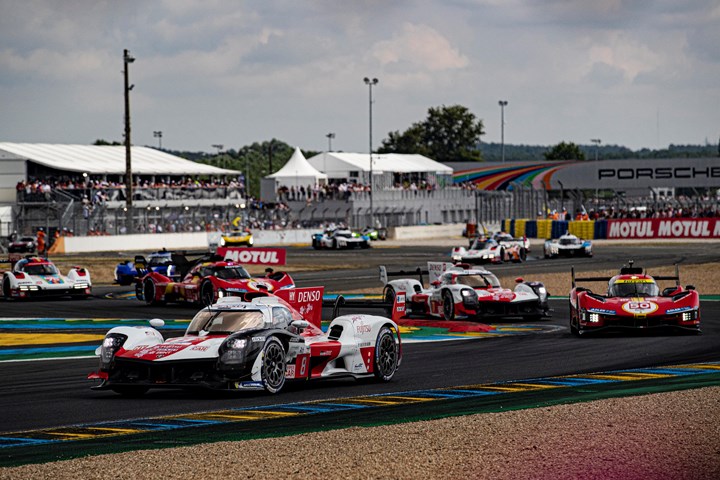
While coming in first is the goal, making the effort to achieving that and falling short are not necessarily a loss. (Image: Toyota Gazoo Racing)
Last weekend the No. 51 Ferrari AF Corse 499P won the Hypercar category of the 24-hour race at Le Mans.
That broke the five-year winning streak that Toyota had at Le Mans, as the No. 8 Toyota GR010 finished second.
However, this is the kind of thing that should be heard from more CEOs—or managers at any level—after their people have done their best but come up short:
“No matter what the circumstances, I am proud of all the members of the team because it is the result of endless efforts and challenge, without giving up. All were heroes.
“There may have been some shortcomings in our challenges. But failure only happens to those who try. It takes tremendous courage to challenge beyond the limits. I believe that courage is the driving force behind changing the future.”—Koji Sato, Toyota Motor Corp. CEO
While some might think the rhetoric is a bit over-wrought (“heroes”?), the message about the importance of trying to go beyond the limits—whether in racing or product development or performing customer service—and recognizing that success isn’t a certainty is something probably not heard from the top often enough—if at all.
///
Le Mans, Somewhat Less Seriously
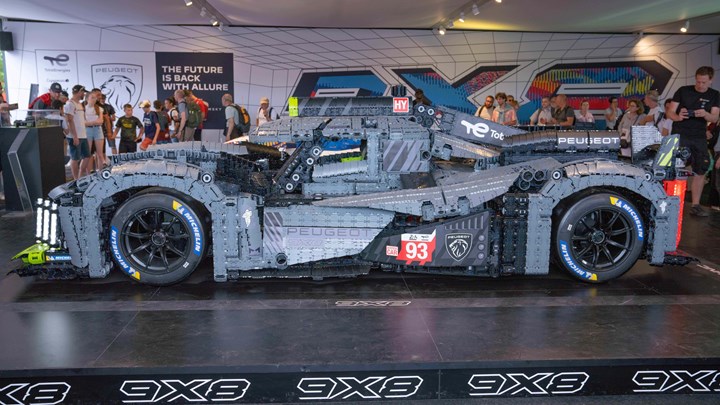
Yes, that’s a Peugeot car for Le Mans. But one made with LEGO (and built in 24 hours). (Image: LEGO)
There was another 24-hour endeavor last weekend at Le Mans, this one involving not drivers but designers, engineers and builders.
A group of 12 from the LEGO Group scaled a LEGO Technic PEUGEOT 9x8 Le Mans hybrid hypercar to 11:1 scale in 24 hours.
Apparently building a model of that scale ordinarily takes eight builders five months.
The model is built with 626,392 LEGO Technic elements.
Cleverly, they created “hyper elements” consisting of from 1,500 to 2,000 individual pieces. 720 hyper elements were used in the build. Think a modular approach to assembly.
The model is 205 inches long, 87 inches wide, 54 inches tall, and weighs ~1,980 pounds.
A bona-fide PEUGEOT 9x8, incidentally, finished 8th in the Hypercar category.
///
One More Thing About Le Mans
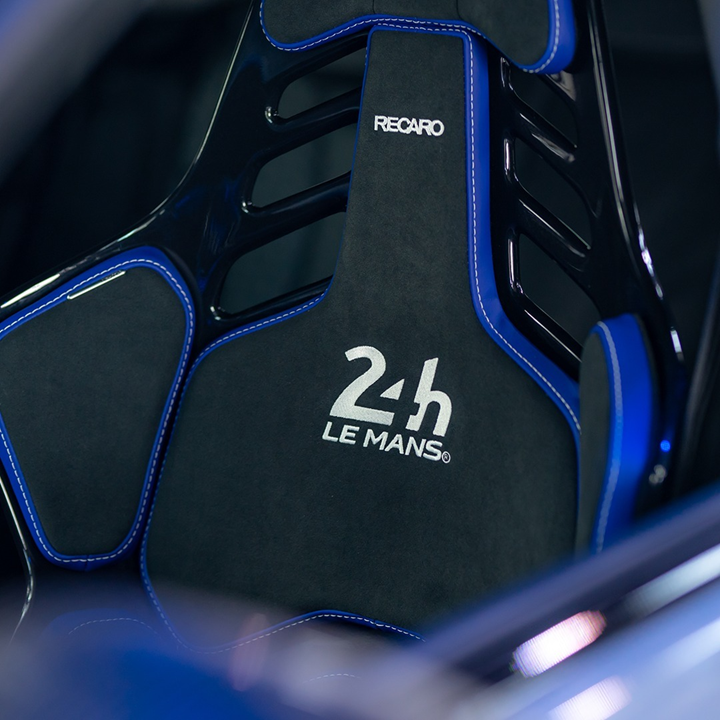
Although you didn’t race at Le Mans, you can get a RECARO seat for your daily driver that makes you feel like you did. (Image: RECARO)
This past weekend race marked the 100th anniversary of the Le Mans race.
This year is also the 60th anniversary of RECARO, a company that is known for seats that are generally installed in vehicles that go really fast on tracks and elsewhere.
So the Automobile Club de l'Ouest, the organizer of the race, agreed that the seat producer could create a tribute seat, the limited edition “Podium GF 24H Le Mans.”
It is a street-legal and FIA-approved glass fiber shell that comes with two thicknesses of padding—20 mm and 10 mm—based on the, um, padding of the driver.
Odds are, none of us has a Le Mans-caliber car in the garage.
Which got us to wondering whether the Podium GF could be installed in practically any car.
Turns out it can.
But the word from RECARO Automotive: “We recommend having a licensed installer do the install.”
Of course.
RELATED CONTENT
-
on lots of electric trucks. . .Grand Highlander. . .atomically analyzing additive. . .geometric designs. . .Dodge Hornet. . .
EVs slowdown. . .Ram’s latest in electricity. . .the Grand Highlander is. . .additive at the atomic level. . .advanced—and retro—designs. . .the Dodge Hornet. . .Rimac in reverse. . .
-
GM Develops a New Electrical Platform
GM engineers create a better electrical architecture that can handle the ever-increasing needs of vehicle systems
-
Choosing the Right Fasteners for Automotive
PennEngineering makes hundreds of different fasteners for the automotive industry with standard and custom products as well as automated assembly solutions. Discover how they’re used and how to select the right one. (Sponsored Content)


.jpg;width=70;height=70;mode=crop)






